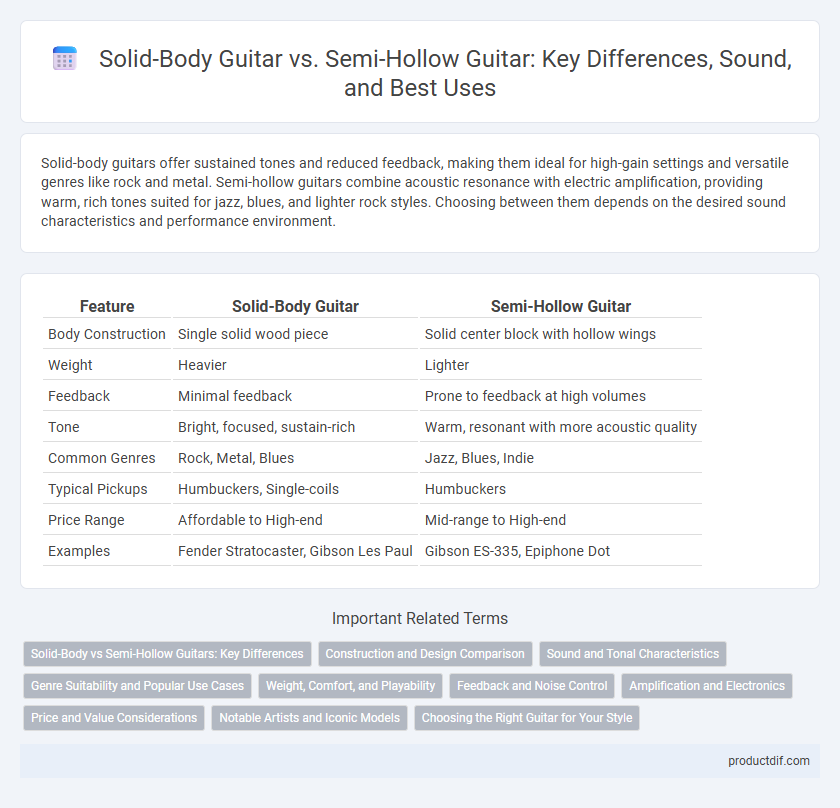Solid-body guitars offer sustained tones and reduced feedback, making them ideal for high-gain settings and versatile genres like rock and metal. Semi-hollow guitars combine acoustic resonance with electric amplification, providing warm, rich tones suited for jazz, blues, and lighter rock styles. Choosing between them depends on the desired sound characteristics and performance environment.
Table of Comparison
| Feature | Solid-Body Guitar | Semi-Hollow Guitar |
|---|---|---|
| Body Construction | Single solid wood piece | Solid center block with hollow wings |
| Weight | Heavier | Lighter |
| Feedback | Minimal feedback | Prone to feedback at high volumes |
| Tone | Bright, focused, sustain-rich | Warm, resonant with more acoustic quality |
| Common Genres | Rock, Metal, Blues | Jazz, Blues, Indie |
| Typical Pickups | Humbuckers, Single-coils | Humbuckers |
| Price Range | Affordable to High-end | Mid-range to High-end |
| Examples | Fender Stratocaster, Gibson Les Paul | Gibson ES-335, Epiphone Dot |
Solid-Body vs Semi-Hollow Guitars: Key Differences
Solid-body guitars feature a solid wood construction, providing increased sustain, feedback resistance, and suitability for high-gain genres like rock and metal, while semi-hollow guitars have a partially hollow body that offers warmer tones and enhanced resonance, ideal for jazz and blues. The solid-body design minimizes feedback issues during distortion, whereas semi-hollow guitars produce a more open, airy sound with some natural acoustic qualities. Weight and comfort also differ, as solid-body guitars tend to be heavier, and semi-hollow models offer a lighter, more ergonomic playing experience.
Construction and Design Comparison
Solid-body guitars feature a solid wood construction that minimizes feedback and enhances sustain, making them ideal for high-gain amplification. Semi-hollow guitars incorporate a solid center block with hollow wings, blending acoustic resonance with electronic amplification for a warmer tone and reduced feedback compared to fully hollow models. The design differences impact weight, tonal characteristics, and suitability for various musical genres, with solid bodies often preferred for rock and metal, while semi-hollows excel in jazz and blues.
Sound and Tonal Characteristics
Solid-body guitars deliver a focused, sustain-rich sound with reduced feedback, making them ideal for high-gain genres like rock and metal. Semi-hollow guitars offer a warmer, resonant tone characterized by acoustic-like depth and a subtle airiness, favored in jazz and blues for their dynamic richness. The choice between the two depends on desired tonal clarity, feedback sensitivity, and musical style nuances.
Genre Suitability and Popular Use Cases
Solid-body guitars excel in genres like rock, metal, and punk due to their higher gain tolerance and reduced feedback, making them ideal for heavy distortion and aggressive playing styles. Semi-hollow guitars are favored in jazz, blues, and indie music for their warm, resonant tones and enhanced acoustic qualities, offering a balanced blend of electric and acoustic sound. Popular use cases for solid-body guitars include live performances and studio recordings demanding clarity and sustain, while semi-hollow models are often chosen for recording clean, articulate sounds and for genres requiring dynamic tonal variation.
Weight, Comfort, and Playability
Solid-body guitars are generally heavier than semi-hollow guitars, offering increased sustain and reduced feedback, which appeals to players seeking stable tone in high-gain settings. Semi-hollow guitars provide lighter weight and enhanced comfort, making extended playing sessions less fatiguing while delivering a warmer, resonant tone with natural acoustic qualities. Playability differences stem from body shape and neck profiles, where semi-hollow designs often allow easier access to upper frets and a more balanced feel, while solid-body guitars excel in durability and resistance to environmental changes.
Feedback and Noise Control
Solid-body guitars offer superior feedback resistance and noise control due to their dense, solid construction, making them ideal for high-gain amplification environments. Semi-hollow guitars, with their partially hollow chambers, are more prone to feedback at high volumes but provide a warmer, resonant tone favored in jazz and blues. Effective noise control in semi-hollow guitars often requires careful amp settings and feedback suppression techniques to maintain clarity during performance.
Amplification and Electronics
Solid-body guitars feature electromagnetic pickups with higher output and less susceptibility to feedback, making them ideal for high-gain amplification and distortion effects. Semi-hollow guitars combine magnetic pickups with an acoustic chamber, producing a warmer tone but increasing feedback sensitivity at high volumes. The choice of amplification and electronics in each type significantly influences tonal versatility and performance in loud environments.
Price and Value Considerations
Solid-body guitars typically offer more affordable options, ranging from $150 to $2000, providing durability and reduced feedback for beginners and professionals alike. Semi-hollow guitars, priced between $500 and $3000, deliver enhanced tonal warmth and resonance but may require careful handling to avoid feedback issues. Evaluating the balance between cost, tonal characteristics, and playing style is essential for selecting the right instrument that maximizes value.
Notable Artists and Iconic Models
Notable artists like Jimmy Page and Joe Satriani have famously used solid-body guitars such as the Gibson Les Paul and Ibanez JS series, known for their sustain and high gain capabilities. Semi-hollow guitars, favored by artists like B.B. King with the Gibson ES-355 and John Scofield with the Ibanez AS-200, deliver warm tones and reduced feedback suitable for jazz and blues. Iconic models like the Fender Telecaster (solid-body) and the Gretsch White Falcon (semi-hollow) have shaped diverse musical genres through their distinctive sounds and construction.
Choosing the Right Guitar for Your Style
Solid-body guitars offer high feedback resistance and sustain, making them ideal for rock and metal genres, while semi-hollow guitars provide warmer tones with natural resonance favored in jazz and blues. Players seeking versatility may prefer semi-hollow models for their blend of acoustic warmth and electric clarity. Considering genre preferences and desired tonal characteristics ensures selecting the right guitar complements your playing style effectively.
Solid-body guitar vs Semi-hollow guitar Infographic

 productdif.com
productdif.com